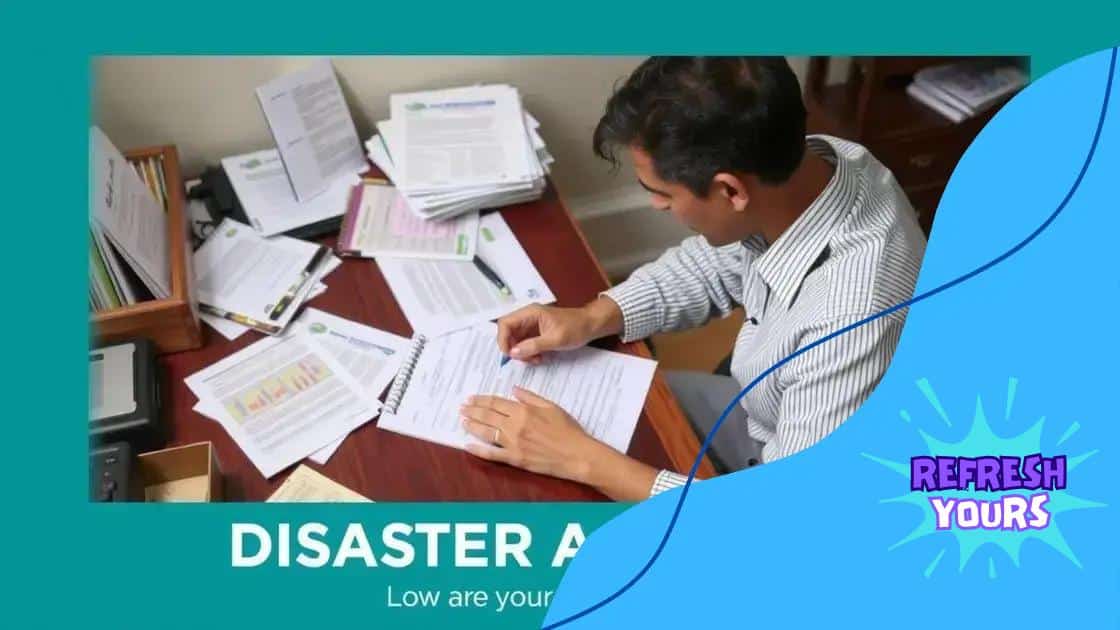How to access financial relief after a disaster

To access financial relief after a disaster, identify eligible programs, gather required documents, accurately complete applications, and follow up regularly for assistance from government and non-profit resources.
How to access financial relief after a disaster is a topic that many individuals face in times of need. Have you ever considered how to navigate the complex world of aid after a catastrophe? In this article, we’ll explore the various options available, guiding you through the steps to secure assistance.
Understanding disaster relief programs
Understanding disaster relief programs is essential for navigating the recovery process. After a disaster, many individuals and families find themselves in need of immediate assistance. There are numerous programs in place to aid those affected, but knowing where to start can be overwhelming.
Many government agencies and non-profit organizations offer disaster relief programs. These programs can help with food, shelter, medical needs, and financial support. Understanding the different types of aid available can simplify the process of recovery.
Types of disaster relief programs
There are several key types of programs to consider:
- Federal assistance: This includes funds and resources from the Federal Emergency Management Agency (FEMA) and other government bodies.
- State and local resources: Many states have their own disaster relief programs, often designed to address specific regional needs.
- Non-profit organizations: Groups like the Red Cross and local charities provide immediate aid and support for recovery.
- Community support: Neighbors and local volunteers can also play a crucial role in the recovery process.
Each of these programs aims to address different aspects of recovery. For instance, federal assistance often focuses on large-scale disasters, while local organizations might help with immediate needs such as food or temporary housing. Knowing who to contact can speed up the help you receive.
How to access these programs
To access disaster relief programs, take the following steps:
- Assess your needs: Determine what kind of assistance you require and the urgency of your situation.
- Research available resources: Use online resources and local contacts to find applicable programs for your situation.
- Gather necessary documentation: Ensure you have important documents, like identification and proof of loss, to expedite your application.
- Contact the relevant agencies: Reach out directly to organizations and agencies that can provide the assistance you need.
By understanding how to navigate these systems effectively, you can make sure that you receive the help you need promptly. Remember, there are people and resources available to assist you in your recovery from a disaster.
Eligibility criteria for financial aid
Eligibility criteria for financial aid play a crucial role in determining who can receive assistance after a disaster. Understanding these criteria can help streamline the application process and ensure that you get the support you need.
Most aid programs base their eligibility on several factors, which can include your financial situation, the extent of loss, and your residency status. By being aware of these requirements, you can prepare your application more effectively.
Common eligibility requirements
Here are some typical criteria you might encounter:
- Proof of loss: Applicants usually need to demonstrate the damage or loss sustained due to the disaster.
- Income level: Many programs assess household income to determine eligibility for aid.
- Residency: Generally, assistance is limited to individuals living in specific affected areas.
- Insurance coverage: Some programs may require that applicants seek aid from their insurance, if applicable.
These criteria exist to ensure that help goes to those who are neediest. Meeting these requirements can be the first step toward getting timely and effective assistance.
Documenting your eligibility
To demonstrate your eligibility for financial aid, it’s essential to prepare documentation carefully. This can include:
- Identification: Provide valid ID to establish your identity.
- Financial records: Recent pay stubs or bank statements can show your income.
- Damage assessment: Photographic evidence of your property damage can support your claim.
- Insurance information: Include details about any insurance payouts you have received or are expecting.
Having the necessary documents ready can help you navigate the application process more efficiently. Remember, each program can have unique requirements, so check the specific guidelines of the aid program you are applying for.
How to apply for assistance

How to apply for assistance is a vital step in securing the support you need after a disaster. Knowing the process helps simplify what can often feel like an overwhelming task. The application process can vary by program, but there are common steps that most applicants will need to follow.
The first step is to identify which programs you are eligible for. Research the different options to find the one best suited to your situation. Consider resources like government websites and local organizations that can provide information tailored to your needs.
Steps to apply for assistance
Once you’ve determined the right program, here are the steps to follow:
- Gather necessary documents: Collect all relevant paperwork, including identification, proof of loss, and financial records.
- Complete the application: Fill out the application form completely and accurately. Make sure to double-check for errors.
- Submit your application: Follow the submission guidelines carefully. Some programs allow online applications, while others may require mail or in-person submission.
- Follow up: After submission, stay in touch with the agency to track the status of your application.
Each step is crucial in ensuring that your application is processed smoothly. Missing documentation or mistakes can delay the assistance you need.
Tips for a successful application
There are a few strategies you can use to improve your chances of a successful application:
- Be thorough: Provide as much detail as possible on your application to avoid delays.
- Keep a copy: Always make copies of your submitted documents for your records.
- Reach out for help: Don’t hesitate to contact support services or local organizations for guidance throughout the process.
- Stay organized: Keep all documentation and correspondence in one place, making it easier to manage your application.
By carefully following these steps and tips, you can streamline the application process for disaster assistance and increase your chances of receiving the help you need efficiently.
Tips for expediting your application
Tips for expediting your application can make a significant difference in how quickly you receive assistance after a disaster. Knowing these strategies can ensure that your application is processed smoothly and efficiently.
Many applicants worry about delays, especially when they need help urgently. By following a few key tips, you can enhance your chances of a timely response from disaster relief programs.
Key strategies to speed up your application
There are several approaches you can take to expedite the application process:
- Be prepared: Gather all necessary documents before starting your application. This includes identification, proof of loss, and financial records.
- Submit accurately: Ensure all information you provide is correct. Mistakes can lead to delays and additional requests for information.
- Use official channels: Apply through the official website or contact center specified by the relief program to avoid confusion and miscommunication.
- Follow up: After submission, check the status of your application regularly. This shows that you are proactive and allows you to address any issues quickly.
Staying organized during the application process can significantly affect how quickly you receive assistance. Keeping track of deadlines and requirements is critical.
Organize your application materials
Another important tip is to maintain clear organization throughout the process:
- Create a checklist: List all required documents and steps you need to take for the application, keeping track of what you have completed.
- Set deadlines: Give yourself specific dates to finish each part of the application, keeping you on schedule.
- Use binders or folders: Store all application-related materials in one place, making retrieval easy when needed.
- Request assistance: Reach out for help if you feel stuck. Many organizations offer guidance on filling out applications.
By implementing these tips, you can enhance your efficiency when applying for disaster relief, increasing your chances of receiving timely support.
Resources for disaster recovery support
Resources for disaster recovery support are essential for individuals and families trying to rebuild their lives after a disaster. Knowing where to find help can greatly reduce stress during a challenging time.
There are numerous resources available, including government programs, non-profit organizations, and community support services. Identifying which resources fit your needs can help you access the right kind of assistance quickly.
Types of recovery resources
Some of the main resources you may consider include:
- Government agencies: Federal and state programs, such as the Federal Emergency Management Agency (FEMA), offer various types of aid, including financial assistance and housing support.
- Non-profit organizations: Organizations like the American Red Cross and local charities provide emergency assistance, supplies, and recovery guidance.
- Community resources: Local churches and community centers often have programs to assist disaster victims with food, shelter, and emotional support.
- Online resources: Websites and hotlines that provide information on available assistance and steps for recovery can be invaluable.
Utilizing these resources can significantly aid in your recovery process. Each resource may have its unique offerings, making it important to explore multiple options.
How to find and access resources
Accessing disaster recovery resources can be straightforward if you know where to look:
- Online searches: Use internet searches to locate organizations that offer recovery support in your area. Keywords like “disaster recovery assistance” can lead you to helpful sites.
- Local government offices: Contact your local government offices to inquire about available programs and resources specifically aimed at disaster recovery.
- Community forums: Attend local community meetings or forums where resources are discussed, often organized by local agencies.
- Social media groups: Joining local support groups on social media can connect you with others who can share resources and advice.
By being proactive in seeking these resources, you can help ensure a smoother recovery experience. Remember that you are not alone; many organizations are ready and willing to assist you on your journey to recovery.
In summary, accessing financial relief after a disaster involves understanding available resources, knowing eligibility criteria, and submitting applications promptly. By following the steps outlined and utilizing tips for expediting applications, you can navigate the recovery process more effectively. Remember, there are many organizations and programs ready to help you rebuild your life, so don’t hesitate to reach out for assistance.
FAQ – Frequently Asked Questions About Accessing Financial Relief After a Disaster
What types of assistance are available after a disaster?
Various types of assistance are available, including federal aid, state programs, non-profit support, and community resources.
How do I know if I’m eligible for financial aid?
Eligibility typically depends on factors like income level, proof of loss, residency status, and insurance coverage.
What documents do I need to apply for assistance?
You will usually need identification, proof of loss, financial records, and any relevant insurance information.
How can I speed up my application for aid?
To expedite your application, gather all necessary documents in advance, submit accurate information, and follow up regularly on its status.





